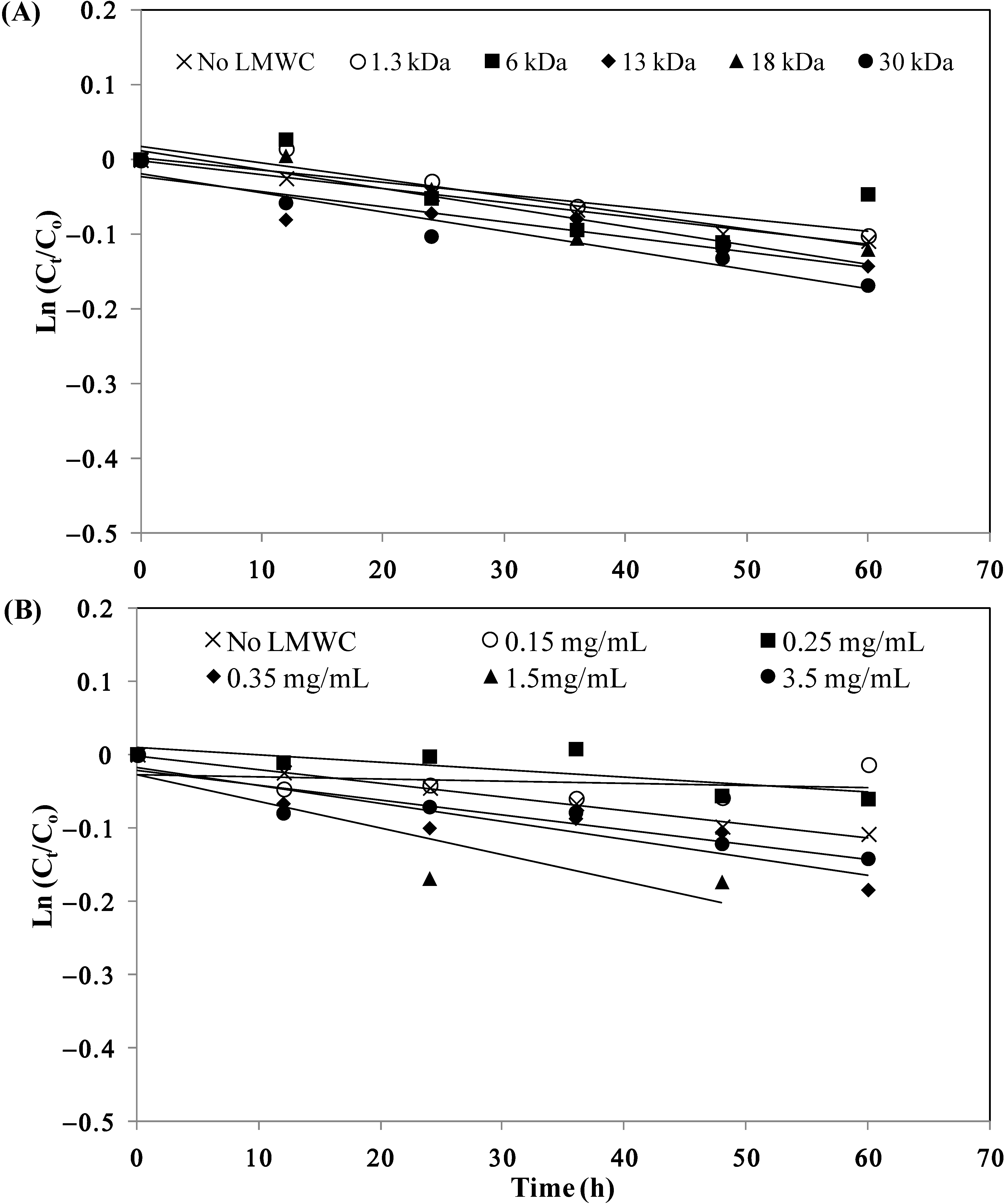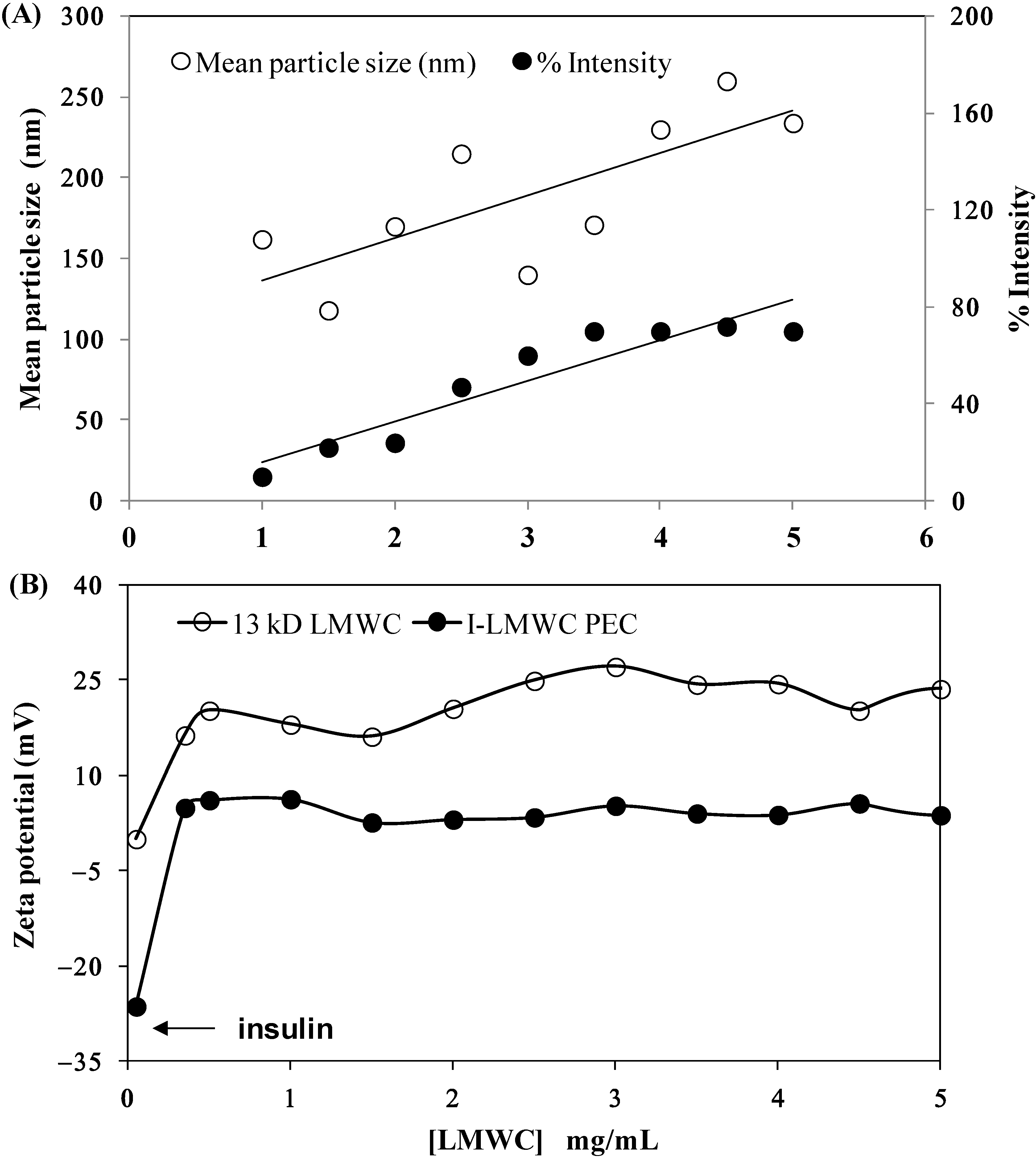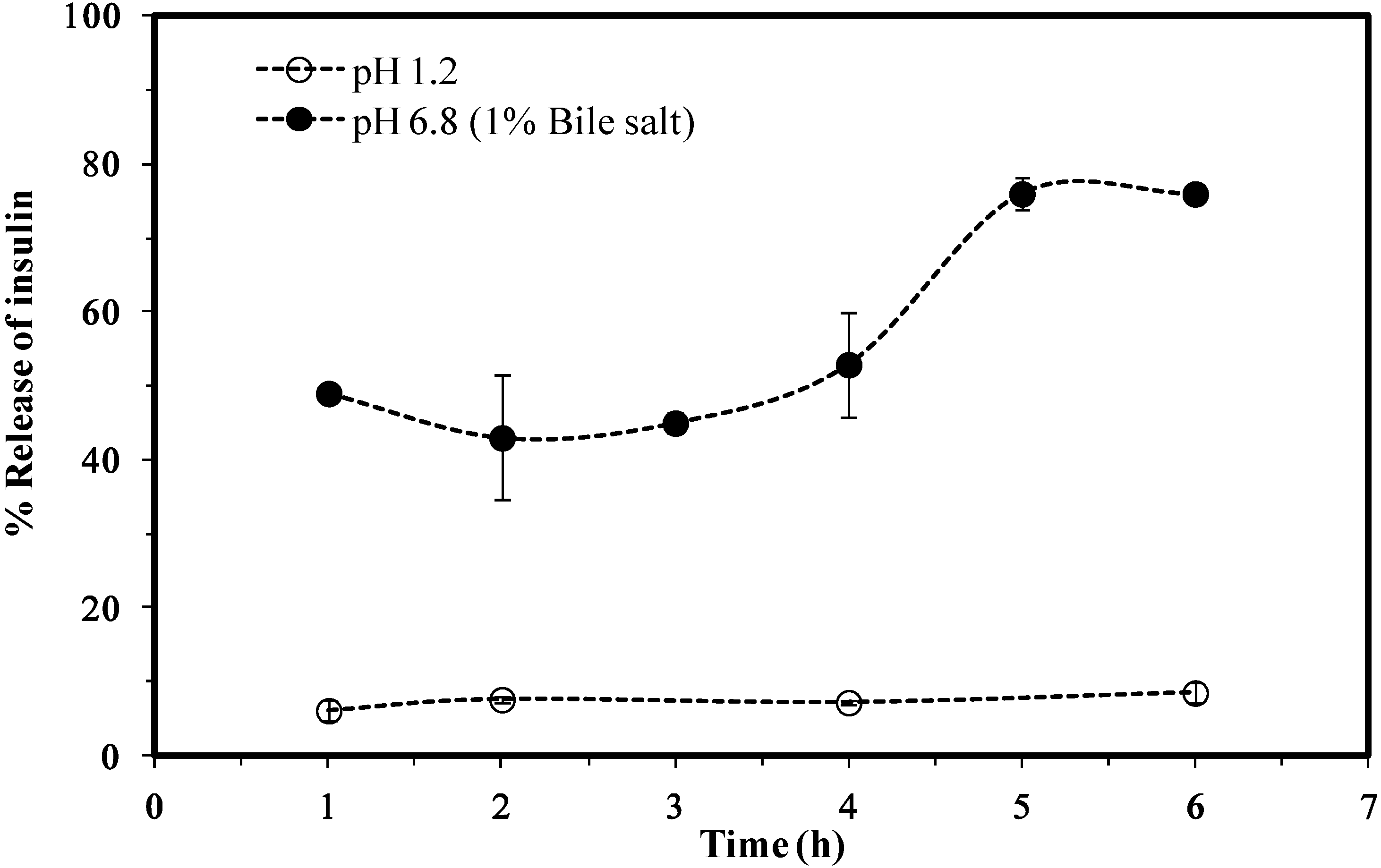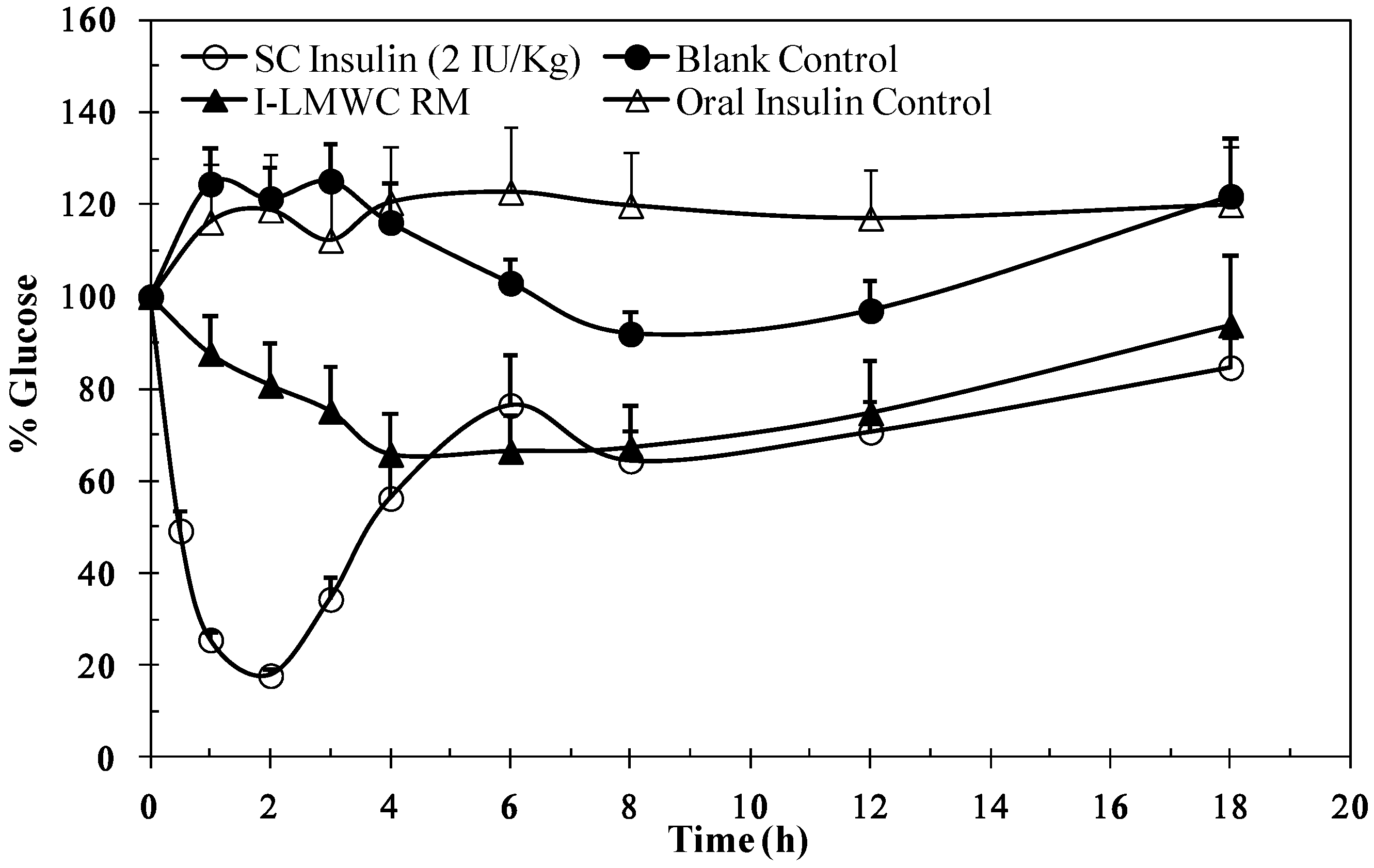Low Molecular Weight Chitosan–Insulin Polyelectrolyte Complex: Characterization and Stability Studies
Abstract
:1. Introduction
2. Results and Discussion
2.1. HPLC Methods Verification

| Analytical Parameter | Result |
|---|---|
| Linearity Range | |
| - 0.9–10.0 mg/mL | R2 = 0.9998 |
| Specificity | |
| - Interference | No interference from formulation components and related compounds |
| Precision (%) | |
| - Inter-day RSD (n = 3 × 3) | 0.8–1.1 |
| - Intra-day RSD (n = 5) | 0.7–0.9 |
| Recovery (%) | 98.3 ± 0.9 |
| DL (mg/mL) | 0.02 |
| QL (mg/mL) | 0.08 |
| Stability of Solution | |
| - Decrease in assay at ambient condition | 2.5% decrease in assay after 24 h |
| System Suitability | |
| - Resolution between insulin and A-21 desamido insulin | 3.7 |
| - Tailing factor for insulin peak | <1.8 |
| - RSD of replicate injections | <1.6% |
2.2. Effect of the Molecular Weight and Concentration of LMWC on Insulin Stability

| LMWC Molecular Weight (kDa) *,+ | Insulin/LMWC Molar Ratio | k (h−1) × 103 | t90 (h) | t50 (h) | R2 |
|---|---|---|---|---|---|
| 0.0 | - | 1.2 | 88 | 587 | 0.2065 |
| 1.3 | 1/4.5 | 2.2 | 48 | 315 | 0.8780 |
| 6 | 1/1 | 1.6 | 64 | 423 | 0.4835 |
| 13 | 1/0.45 | 2.0 | 52 | 344 | 0.8428 |
| 18 | 1/0.3 | 2.5 | 42 | 274 | 0.8831 |
| 30 | 1/0.2 | 2.6 | 41 | 272 | 0.9388 |
| [13 kDa LMWC] (mg/mL) + | |||||
| 0.0 | - | 1.2 | 88 | 587 | 0.2065 |
| 0.15 | 1/0.02 | 1.3 | 81 | 533 | 0.9200 |
| 0.25 | 1/0.03 | 1.0 | 102 | 675 | 0.5871 |
| 0.35 | 1/0.045 | 2.4 | 43 | 283 | 0.8388 |
| 1.5 | 1/0.2 | 3.6 | 29 | 191 | 0.7704 |
| 3.5 | 1/0.45 | 2.0 | 52 | 344 | 0.8428 |
2.3. Effect of the Molecular Weight of LMWC on Immunological Bioactivity of Insulin
| LMWC Molecular Weight (kDa) | Bioactivity (%) | RSD |
|---|---|---|
| No LMWC | 58.9 * | 10.3 |
| 1.3 | 91.1 | 3.1 |
| 6 | 92.3 | 4.7 |
| 13 | 102.9 | 6.7 |
| 18 | 94.6 | 6.1 |
| 30 | 97.1 | 5.7 |
2.4. Characterization of I-LMWC PEC and I-LMWC RM Systems

| LMWC Concentration (mg/mL) | pHf | AE ± RSD (%) |
|---|---|---|
| 0.7 | 6.5 | 63.8 ± 2.1 |
| 3.0 | 6.5 | 76.2 ± 3.2 |
| 0.7 | 6.7 | 22.7 ± 2.8 |
| 3.0 | 7.0 | 8.6 ± 4.6 |
2.5. In Vitro Evaluation of I-LMWC PEC and I-LMWC RM
2.5.1. In Vitro Release

2.5.2. In Vitro Evaluation of the Protective Effect
2.6. Biological Activity

3. Experimental Section
3.1. Materials
3.2. Determination of Molecular Weight of LMWCs
3.3. Preparation of I-LMWC PEC
3.4. Preparation of I-LMWC RM
3.5. Extraction Procedures
3.6. HPLC Determination of Insulin
3.7. Size Exclusion HPLC Determination of High Molecular Weight Proteins (HMWPs)
3.8. HPLC Method Verification
3.9. Stability of I-LMWC PEC
3.10. Immunological Bioactivity of Insulin
3.11. Characterization of I-LMWC PEC
3.12. In Vitro Evaluation of I-LMWC PEC and I-LMWC RM
3.12.1. In Vitro Release
3.12.2. In Vitro Evaluation of the Protective Effect
3.13. In Vivo Pharmacological Activity
4. Conclusions
Acknowledgments
Author Contributions
Conflicts of Interest
References
- Hiroyuki, H.; Tsutomu, A.; Kentaro, S. Effect of additives on protein aggregation. Curr. Pharm. Biotechnol. 2009, 19, 400–407. [Google Scholar]
- Aranaz, I.; Harris, R.; Heras, A. Chitosan amphiphilic derivatives chemistry and applications. Curr. Org. Chem. 2010, 14, 308–330. [Google Scholar] [CrossRef]
- Junginger, H.E. Polymeric permeation enhancers. In Oral Delivery of Macromolecular Drugs; Bernkop-Schnürch, A., Ed.; Springer Dordrecht Heidelberg: New York, NY, USA, 2009; pp. 103–136. [Google Scholar]
- Mao, S.; Germershaus, O.; Fischer, D.; Linn, T.; Schnepf, R.; Kissel, T. Uptake and transport of PEG-graft-trimethyl-chitosan copolymer-insulin nanocomplexes by epithelial cells. Pharm. Res. 2005, 22, 2058–2068. [Google Scholar] [CrossRef]
- Sadeghi, A.M.; Dorkoosh, F.A.; Avadi, M.R.; Saadat, P.; Rafiee-Tehrani, M.; Junginger, H.E. Preparation, characterization and antibacterial activities of chitosan, N-trimethyl chitosan (TMC) and N-diethylmethyl chitosan (DEMC) nanoparticles loaded with insulin using both the ionotropic gelation and polyelectrolyte complexation methods. Int. J. Pharm. 2008, 355, 299–306. [Google Scholar] [CrossRef] [PubMed]
- Berger, J.; Reist, M.; Mayer, J.; Flet, O.; Gurny, R. Structure and interactions in chitosan hydrogels formed by complexation or aggregation for biomedical application. Eur. J. Pharm. Biopharm. 2004, 57, 35–52. [Google Scholar] [CrossRef]
- Schatz, C.; Bionaz, A.; Lucas, J.M.; Pichot, C.; Viton, C.; Domard, A.; Delair, T. Formation of polyelectrolyte complex particles from self-complexation of N-sulfated chitosan. Biomacromolecules 2009, 10, 1402–1409. [Google Scholar] [CrossRef] [PubMed]
- Mao, S.; Bakowsky, U.; Jintapattanakit, A.; Kissel, T. Self-assembled polyelectrolyte nanocomplexes between chitosan derivatives and insulin. J. Pharm. Sci. 2006, 95, 1035–1048. [Google Scholar] [CrossRef] [PubMed]
- Lin, Y.H.; Mi, F.L.; Chen, C.T.; Chang, W.C.; Peng, S.F.; Liang, H.F.; Sung, H.W.Y. Preparation and characterization of nanoparticles shelled with chitosan for oral insulin delivery. Biomacromolecules 2007, 8, 146–152. [Google Scholar] [CrossRef] [PubMed]
- Jintapattanakit, A.; Junyaprasert, V.B.; Mao, S.; Sitterberg, J.; Bakowsky, U.; Kissel, T. Peroral delivery of insulin using chitosan derivatives: A comparative study of polyelectrolyte nanocomplexes and nanoparticles. Int. J. Pharm. 2007, 342, 240–249. [Google Scholar] [CrossRef] [PubMed]
- Song, L.; Zhi, Z.L.; Pickup, J.C. Nanolayer encapsulation of insulin-chitosan complexes improves efficiency of oral insulin delivery. Int. J. Nanomedicine 2014, 9, 2127–2136. [Google Scholar] [PubMed]
- Tozaki, H.; Komoike, J.; Tada, C.; Maruyama, T.; Terabe, A.; Suzuki, T.; Yamamoto, A.; Muranishi, S. Chitosan capsules for colon-specific drug delivery: Improvement of insulin absorption from the rat colon. J. Pharm. Sci. 1997, 86, 1016–1021. [Google Scholar] [CrossRef] [PubMed]
- Badwan, A.A.; Al-Remawi, M.; El-Thaher, T.; Elsayed, A. Oral delivery of protein drugs using microemulsion. EP1797870, 20 June 2007. [Google Scholar]
- Elsayed, A.; Remawi, M.A.; Qinna, N.; Farouk, A.; Badwan, A. Formulation and characterization of an oily-based system for oral delivery of insulin. Eur. J. Pharm. Biopharm. 2009, 73, 269–279. [Google Scholar] [CrossRef] [PubMed]
- Assaf, S.M.; Al Jbour, N.D.; Eftaiha, A.F.; Elsayed, A.M.; Al Remawi, M.M.; Qinna, N.A.; Chowdhry, B.; Leharne, S.; Badwan, A.A. Factors involved in formulation for proteins based on PEG-8 caprylic/capric glycerides and polyglyceryl-6-diolate in a mixture of oleic acid with chitosan. J. Dispers. Sci. Technol. 2011, 32, 623–633. [Google Scholar] [CrossRef]
- Insulin Human Monograph. In United States Pharmacopeia; Unites States Pharmacopeia Convention: Rockville, MD, USA, 2013; pp. 3913–3914.
- Smith, D.J.; Venable, R.M.; Collins, J. Separation and quantitation of insulins and related substances in bulk insulin crystals and in injectables by reversed-phase high performance liquid chromatography and the effect of temperature on the separation. J. Chromatogr. Sci. 1985, 23, 81–88. [Google Scholar] [CrossRef] [PubMed]
- Zhang, K.; Quan, C.; Huang, H.; Taulier, N.; Wu, X.Y. On the stability of insulin delivered through a new glucose-responsive polymeric composite membrane. J. Pharm. Pharmacol. 2004, 56, 611–620. [Google Scholar] [CrossRef] [PubMed]
- Bilati, U.; Allemann, E.; Doelker, E. Strategic approaches for overcoming peptide and protein instability within biodegradable nano- and microparticles. Eur. J. Pharm. Biopharm. 2005, 59, 375–388. [Google Scholar] [CrossRef] [PubMed]
- ORA Laboratory Procedure. USFDA. Available online: http://www.fda.gov/ScienceResearch/ FieldScience/ucm171877.htm (accessed on 6 August 2013).
- Sarmento, B.; Ribeiro, A.; Veiga, F.; Ferreira, D. Development and validation of a rapid reversed-phase HPLC method for the determination of insulin from nanoparticulate systems. Biomed. Chromatogr. 2006, 20, 898–903. [Google Scholar] [CrossRef]
- Iwasa, S.; Enomoto, A.; Onoue, S.; Nakai, M.; Yajima, T.; Fukushima, T. Chromatographic analysis of conformationally changed insulin and its cytotoxic effect on PC12 cells. J. Health Sci. 2009, 55, 825–831. [Google Scholar] [CrossRef]
- Hansen, J.F. The self-association of zinc-free human insulin and insulin analogue B13-glutamine. Biophys. Chem. 1991, 39, 107–110. [Google Scholar] [CrossRef] [PubMed]
- Hvidt, S. Insulin association in neutral solution studied by light scattering. Biophys. Chem. 1991, 39, 205–213. [Google Scholar] [CrossRef] [PubMed]
- Sluzky, V.; Klibanov, A.M.; Langer, R. Mechanism of insulin aggregation and stabilization in agitated aqueous solutions. Biotechnol. Bioeng. 1992, 40, 895–903. [Google Scholar] [CrossRef] [PubMed]
- Dathe, M.; Gast, K.; Zirwer, D.; Welfle, H.; Mehlis, B. Insulin aggregation in solution. Int. J. Pept. Protein Res. 1990, 36, 344–349. [Google Scholar] [CrossRef] [PubMed]
- Ugwu, S.O.; Apte, S.P. The effect of buffers on protein conformational stability. Pharm. Technol. 2004, 9, 86–113. [Google Scholar]
- Brange, J.; Owens, D.R.; Kang, S.; Vølund, A. Monomeric insulin and their experimental and clinical implications. Diabetes Care 1990, 13, 923–954. [Google Scholar] [CrossRef] [PubMed]
- Brange, J.; Havelund, S.; Hougaard, P. Chemical stability of insulin. 2. Formation of higher molecular weight transformation products during storage of pharmaceutical preparations. Pharm. Res. 1992, 9, 727–734. [Google Scholar] [CrossRef] [PubMed]
- Robbins, D.C.; Cooper, S.M.; Fineberg, S.E.; Mead, P.M. Antibodies to covalent aggregates of insulin in blood of insulin-using diabetic patients. Diabetes 1987, 36, 838–841. [Google Scholar] [CrossRef] [PubMed]
- Ratner, R.E.; Phillips, T.M.; Steiner, M. Persistent cutaneous insulin allergy resulting from high-molecular-weight insulin aggregates. Diabetes 1990, 39, 728–733. [Google Scholar] [CrossRef] [PubMed]
- Mansur, H.S.; Oréfice, R.L.; Vasconcelos, W.L.; Lobato, Z.P.; Machado, L.J. Biomaterial with chemically engineered surface for protein immobilization. J. Mater. Sci. Mater Med. 2005, 16, 333–340. [Google Scholar] [CrossRef] [PubMed]
- Gander, B.; Wehrli, E.; Alder, R.; Merkle, H.P. Quality improvement of spray-dried, protein-loaded D,L-PLA microspheres by appropriate polymer solvent selection. J. Microencapsul. 1995, 12, 83–97. [Google Scholar] [CrossRef] [PubMed]
- Cleland, J.L.; Mac, A.; Boyd, B.; Yang, J.; Duenas, E.T.; Yeung, D.; Brooks, D.; Hsu, C.; Chu, H.; Mukku, V.; et al. The stability of recombinant human growth hormone in poly(lactic-co-glycolic acid) (PLGA) microspheres. Pharm. Res. 1997, 14, 420–425. [Google Scholar] [CrossRef] [PubMed]
- Petersen, H.; Kunath, K.; Martin, A.L.; Stolnik, S.; Roberts, C.J.; Davies, M.C.; Kissel, T. Star-shaped poly(ethylene glycol)-block-polyethylenimine copolymers enhance DNA condensation of low molecular weight polyethylenimines. Biomacromolecules 2002, 3, 926–936. [Google Scholar] [CrossRef] [PubMed]
- Tsaih, M.L.; Chen, R.H. Effect of molecular weight and urea on the conformation of chitosan molecules in dilute solutions. Int. J. Biol. Macromol. 1997, 20, 233–240. [Google Scholar] [CrossRef] [PubMed]
- Verma, A.; Verma, A. Polyelectrolyte complex–An overview. Int. J. Pharm. Sci. Res. 2013, 4, 1684–1691. [Google Scholar]
- Borchard, G.; Luessen, H.L.; Boer, A.G.; Verhoef, J.C.; Lehr, C.M.; Junginger, H.E. The potential of mucoadhesive polymers in enhancing intestinal peptide drug absorption .3. Effect of chitosan-glutamate and carbomer on epithelial tight junctions in vitro. J. Control. Release 1996, 39, 131–138. [Google Scholar] [CrossRef]
- Ma, Z.H.; Yeoh, H.; Lim, L.Y. Formulation pH modulates the interaction of insulin with chitosan nanoparticles. J. Pharm. Sci. 2002, 91, 1396–1404. [Google Scholar] [CrossRef] [PubMed]
- Lee, D.W.; Lim, C.; Israelachrili, J.; Hwang, D.S. Strong adhesion and cohesion of chitosan in aqueous solutions. Langmuir 2013, 29, 14222–14229. [Google Scholar] [CrossRef] [PubMed]
- Anderson, B.D.; Darrington, R.T. Evidence for a common intermediate in insulin deamidation and covalent dimer formation: Effects of pH and aniline trapping in dilute acidic solutions. J. Pharm. Sci. 1995, 84, 275–282. [Google Scholar] [CrossRef] [PubMed]
- Kabanov, V.A. Basic properties of soluble interpolyelectrolyte complexes applied to bioengineering and cell transformation. In Macromolecular Complexes in Chemistry and Biology; Dubin, P., Bock, J., Davis, R., Schulz, D.N., Thies, C., Eds.; Springer-Verlag: Berlin, Germany, 1994; pp. 151–174. [Google Scholar]
- Wu, Y.; Yang, W.; Wang, C.; Hu, J.; Fu, S. Chitosan nanoparticles as a novel delivery system for ammonium glycyrrhizinate. Int. J. Pharm. 2005, 295, 235–245. [Google Scholar] [CrossRef] [PubMed]
- Kasaai, M.R. Calculation of Mark-Houwink-Sakurada (MHS) equation viscometric constants for chitosan in any solvent-temperature system using experimental reported viscometric constant data. Carbohydr. Polym. 2007, 68, 477–488. [Google Scholar] [CrossRef]
- Verification of compendial procedures <1226>. In United States Pharmacopeia; Unites States Pharmacopeia Convention: Rockville, MD, USA, 2013.
- Validation of Analytical Methods; European Medicine Agency (EMA): London, UK, 1995.
© 2015 by the authors; licensee MDPI, Basel, Switzerland. This article is an open access article distributed under the terms and conditions of the Creative Commons Attribution license (http://creativecommons.org/licenses/by/4.0/).
Share and Cite
Al-Kurdi, Z.I.; Chowdhry, B.Z.; Leharne, S.A.; Al Omari, M.M.H.; Badwan, A.A. Low Molecular Weight Chitosan–Insulin Polyelectrolyte Complex: Characterization and Stability Studies. Mar. Drugs 2015, 13, 1765-1784. https://doi.org/10.3390/md13041765
Al-Kurdi ZI, Chowdhry BZ, Leharne SA, Al Omari MMH, Badwan AA. Low Molecular Weight Chitosan–Insulin Polyelectrolyte Complex: Characterization and Stability Studies. Marine Drugs. 2015; 13(4):1765-1784. https://doi.org/10.3390/md13041765
Chicago/Turabian StyleAl-Kurdi, Zakieh I., Babur Z. Chowdhry, Stephen A. Leharne, Mahmoud M. H. Al Omari, and Adnan A. Badwan. 2015. "Low Molecular Weight Chitosan–Insulin Polyelectrolyte Complex: Characterization and Stability Studies" Marine Drugs 13, no. 4: 1765-1784. https://doi.org/10.3390/md13041765
APA StyleAl-Kurdi, Z. I., Chowdhry, B. Z., Leharne, S. A., Al Omari, M. M. H., & Badwan, A. A. (2015). Low Molecular Weight Chitosan–Insulin Polyelectrolyte Complex: Characterization and Stability Studies. Marine Drugs, 13(4), 1765-1784. https://doi.org/10.3390/md13041765







